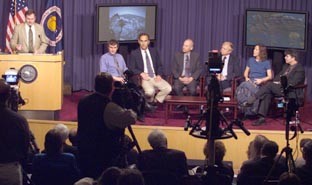Steven Squyres delivers NASA's really big news: Mars once had water
By H. Roger Segelken
WASHINGTON, D.C. -- "We have concluded that the rocks here were once soaked in liquid water. It changed their texture, and it changed their chemistry. We've been able to read the tell-tale clues the water left behind, giving us confidence in that conclusion."
That was the way Steven Squyres, science team leader for the Mars rover mission and Cornell professor of astronomy, announced the powerful evidence found in recent days that Mars once had a watery environment that would be capable of supporting life.
Squyres delivered the news of the probable existence of water in the rover Opportunity's landing site on Meridiani Planum at a hastily called news conference March 2 at NASA headquarters in the nation's capital. He confirmed speculation that had buzzed through the space-science community in the previous 24 hours: that Opportunity, scratching and analyzing its way across the crater where it had landed on Jan. 24 to peer at a curious outcropping of layered rock, had indeed found evidence for a history of liquid water.
And water, he speculated, might have led to life. "We believe at this place on Mars, for some period in time, was habitable," Squyres said. "It was a ground-water environment, the kind of place that would have been suitable for life. That doesn't mean life was there. We don't know that. But this was a habitable place on Mars at one point in time."
Whether the layered sedimentary rock outcrop, dubbed El Capitan, had been deposited in water, in an ancient sea for example, or whether abundant water had been in the same place as much older volcanic rock is impossible to tell at this point, Squyres said, but almost certainly there was plenty of water at one time. And there still may be salty liquid water in the form of brine, tens or hundreds of meters beneath the surface, he added.
Much of the discussion at the press conference, which included four other scientists on the Mars rover mission, centered around the chemistry and geology of three kinds of evidence for water, the main one being a hydrated sulfate mineral called jarosite, rare on Earth but a clear sign of water on Mars (see accompanying story, this page).
Other evidence came in the form of tiny spherules, nicknamed "blueberries," that Opportunity's instruments found embedded in the outcrop and are now considered by scientists to have been formed in water. Judging from shape alone, these spherules might have been formed from volcanic eruptions, from lofting of molten droplets by a meteor impact, or from accumulation of minerals coming out of solution inside a porous, water-soaked rock. Opportunity's observations that the spherules are not concentrated at particular layers in the outcrop weigh against a volcanic or impact origin, but do not completely rule out those origins.
More evidence came from indentations, called vugs, that pictures from Opportunity's panoramic cameras and microscopic imager reveal as oval-shaped holes and that once held minerals in water-soaked rock before the minerals dissolved. The panoramic pictures show that El Capitan is thoroughly pocked with the indentations -- each about a centimeter (0.4 inch) long and one-fourth or less that wide -- with apparently random orientations.
Squyres credited Opportunity's Cornell-developed RAT (rock abrasion tool) with grinding away enough rock surface to find abundant sulfur in the form of sulfate salts, probably similar to common drugstore Epsom salts, that are a telltale sign of liquid water.
But the really big question about when liquid water actually existed on Mars still can't be answered, even though it was asked repeatedly by journalists at the Washington news conference and at four other NASA sites around the country participating via satellite. A good-natured Squyres displayed a little annoyance after the fourth or fifth identical question and instead suggested that a large sample of Mars rock, if brought back to Earth and analyzed in detail, might answer the geological-history question.
"It is very difficult to infer age by looking at pictures," he said patiently, then added that the twin rover Spirit, now in Gusev crater on the other side of Mars, might turn up something when it reaches a crater, named Bonneville, in a week to 10 days.
Looking ahead to Opportunity's agenda, Squyres said the rover would examine more closely an accumulation of the BB-size spherules in a feature he called the blueberry bowl. Also, Opportunity would try to study deposits of the mineral hematite located above El Capitan, where the rover has concentrated its efforts. Hematite "is a chemical beacon that something interesting happened here," Squyres said.
Space scientists have long known that frozen water still exists at the Martian polar caps. One of the two rovers' goals was to determine whether large amounts of liquid water ever covered other parts of the planet and whether that would have given some form of life a start on the planet.
It took a human-interest question from a Chinese journalist -- "for Dr. Steve: What are your personal feelings?" -- to reveal the scientific drama that was occurring back at JPL's mission control in Pasadena, Calif. Noting that the Mars rover team had worked for years to get to this point, Squyres said the scientists had two attitudes to the possibility of a watery Mars. "Some of us leapt joyfully over the cliff. Others had to be dragged over. It took time to be convinced."
Get Cornell news delivered right to your inbox.
Subscribe


